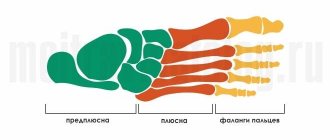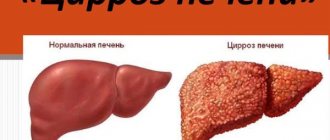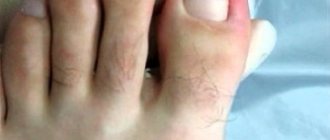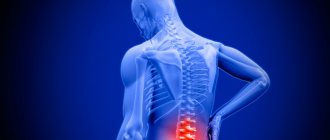Causes of pain
Pain in the soft tissue area occurs for various reasons. They can be both physiological and associated with pathological processes in the human body.
Physiological
If the leg muscle above the knee hurts, then the reason does not necessarily have to be the development of any disease. Most often, causeless pain is provoked by excessive physical exertion, so it often worries people who are actively involved in sports or do physical work.
The occurrence of a pain symptom in this case is associated with stagnation of lactic acid in the muscles. It causes painful sensations that last for 2-3 days and have a burning character.
Another physiological reason that causes aching pain in the leg muscles is wearing uncomfortable shoes. This is especially true for women who prefer to wear high heels. In this case, you should select your shoes more carefully.
Staying in one position for a long time can cause pain. In such a situation, the blood vessels are compressed, the muscles are tense, and they do not receive enough nutrition. This entails numbness of the tissues, a stabbing sensation, and nagging pain. Unpleasant signs disappear immediately after blood flow is restored.
Also, muscle pain is a frequent companion of women carrying a child. It especially manifests itself in late pregnancy. The reason lies in the increased load on the legs, which occurs due to weight gain.
Pathological
If pain in muscle tissue is accompanied by other symptoms, then there is a high risk of developing diseases of the leg muscles, joints or bones. The following diseases can provoke pain:
- Fibromyalgia. This is an extensive lesion of the leg muscles, in which dull pain is observed. It is localized in different parts of the limb.
- Cramps. This phenomenon is associated with insufficient amounts of calcium, magnesium and potassium in the body, as well as dehydration. The favorite place of the syndrome is the calves. The patient experiences severe pain, accompanied by tissue stiffness and a burning sensation.
- Myositis. The disease is inflammatory in nature. In most cases, it develops as a result of viral pathology and excessive physical stress on the legs. The pain in front above the knee or behind it is dull and growing in nature.
- Osteomyelitis. The pathology occurs due to the penetration of infection into bone tissue, accompanied by a purulent process spreading to the muscles. The pain with such a disease is very pronounced, sometimes the aches are simply unbearable.
- Neuralgia. The disease occurs due to pinched nerves. As a result, the leg ache severely, pain permeates the tissues. The appearance of the symptom is often associated with a sudden movement of the hip.
- Intervertebral hernia. With a tumor in the vertebrae, pain can radiate to the femoral area. Patients often experience numbness in their limbs.
If you suspect the development of these pathologies, you should consult a doctor. You may need to be examined by specialists such as a neurologist, phlebologist, or orthopedist.
Timely consultation with a doctor is necessary in order to prevent conditions that pose a threat to human life.
Alarming symptoms
Arthralgia and myalgia (pain in joints and muscles, respectively) are characteristic of the acute stages of coronavirus. They often represent residual effects after severe systemic intoxication. However, we cannot exclude the development or exacerbation of articular and autoimmune diseases - in particular, rheumatism and rheumatoid arthritis.
Poisoning by viral toxins is a painful but natural process that is one of the key signs of an acute respiratory infection. To one degree or another, it is present in every person. Therefore, it is worth paying attention to some features of the symptoms so as not to miss complications.
Alarming symptoms:
- the pain seemed to go away, but returned 2 weeks after recovery;
- joints begin to swell, or leg muscles swell;
- because of the pain you have to limp, and this continues for several days;
- joints and adjacent tissues are unusually hot or, conversely, cold;
- General condition worsened, body temperature increased.
The listed signs directly indicate that a complication has begun and the help of a doctor is required. The latter is necessary even for mild pain - if only the calf muscles hurt, or the discomfort lasts more than a week.
Complications from the musculoskeletal system are not so much to blame for the virus itself as for the consequences it causes. The infection takes a toll on the body, and new viral strains confuse the immune system. Drug therapy adds “fuel to the fire” and has additional toxic effects.
Characteristics and localization of leg pain
The “culprit” of muscle pain can be not only the tissues themselves, but also bones, joints, and blood vessels, so the unpleasant sensations have a different character. If it is painful for a patient to walk as a result of diseases or injuries to joints and tendons, then the pain syndrome:
- has an exact localization - in the direction of the affected joint;
- becomes stronger during movement;
- often accompanied by a crunching sound, limited mobility of the foot or knee, redness of the leg;
- develops gradually.
Diagnostics
If your leg muscles in the area of the feet, legs and thighs regularly hurt, you should visit a doctor to find out the cause of the unpleasant condition. Only a comprehensive examination will help determine the nature of the painful symptom. First of all, the doctor conducts an external examination, interviews the patient regarding the clinical picture, existing diseases, and lifestyle.
After an external examination of the legs to make a final diagnosis, the specialist prescribes:
- Laboratory blood test for general clinical and biochemical parameters.
- Magnetic resonance imaging.
- X-ray.
- Ultrasound examination with Doppler.
- Angiography.
MRI and ultrasound are used to check the condition of muscle tissue. For injuries of bones and joints, an X-ray examination is performed. The vessels are checked using angiography.
Convulsions
Involuntary muscle contractions are called cramps. Manifest in individual muscles and muscle groups. The lower legs and calf muscles suffer. Causes: physical stress, overwork. Occurs in the calf region of the lower limb. Cramps are a common occurrence in pregnant women. Cope with cramps as follows:
- relax the muscle (change the position of the leg);
- rub vigorously with your hands;
- Apply a wet cold towel or stand barefoot on the floor.
Sharp objects (needle, knitting needle, pen) help. Prick the calf muscle. After a few seconds the discomfort will go away. At the first sign of a cramp, sharply pull your feet towards you.
Seizures are a common occurrence. Most people have experienced cramping discomfort, which is not difficult to relieve.
Leg cramps
Treatment
After finding out the exact reason why the leg hurts above the knee in front, behind or on the side, the treating doctor prescribes a course of health measures. The treatment method is selected depending on the specific pathology. First of all, treatment is aimed at eliminating the factor that provoked the pain, but symptomatic therapy is also used.
To combat leg pain, medications, physiotherapeutic procedures, physical therapy, and massage are used. In severe situations, surgical intervention is resorted to.
Medications
Medicines are used to treat any pathology. Depending on the disease, doctors prescribe medications in the form of ointments, tablets, and injections.
Consequences
If constant pain in the leg muscles is associated with pathological processes, then they must be treated. Otherwise, there is a high risk of complications. Their severity depends on the existing disease.
Undesirable consequences include:
- Chronic manifestation of pain.
- Limited movement or complete immobilization of the lower limb.
- Thrombosis, thrombophlebitis.
- Amyotrophy.
- Tissue contracture.
- Severe nerve damage leading to paralysis of the legs.
Only timely treatment and strict adherence to the instructions of the attending physician will help avoid complications.
Vein diseases
Leg pain is accompanied by:
- Varicose veins;
- phlebitis and thrombophlebitis;
- postthrombophlebitic syndrome.
Varicose veins
This disease is widespread and is a very pressing problem in medicine and cosmetology.
Find out more about the promotion >>>
Phlebitis and thrombophlebitis
Phlebitis is inflammation of a vein. Thrombophlebitis is a complication of phlebitis or varicose veins of the lower extremities. With thrombophlebitis, a blood clot forms in the inflamed vein. Pain is a concern and swelling of the legs is possible.
Deep vein thrombosis is fraught with complications, the most dangerous of which are venous gangrene of the limb (with high blockage and blockage of all outflow pathways of venous blood) and pulmonary embolism. The risk of thromboembolism is highest in the presence of an unfixed - floating thrombus. The larger the detached fragment of the blood clot, the greater the likelihood of an unfavorable outcome, including death.
A common complication of deep vein thrombophlebitis is postthrombophlebitis syndrome.
Prevention
To prevent muscle pain, you should be attentive to your health. The main rule concerns sports. This is very beneficial for the body, but exercise should be moderate and regular. It is important to warm up your feet before exercising to avoid tissue damage and choose comfortable running shoes.
Prevention also includes timely treatment of inflammatory pathologies, proper nutrition, giving up bad habits, and rational dosing of work and rest.
If pain in the leg muscles occurs too often when walking or at rest, you should not ignore them: the cause of the pain syndrome can be quite serious.
Neurogenic myalgia
Neuromuscular diseases, when muscle function is disrupted, i.e. damage to the muscles themselves or due to dysfunction of the neuromuscular junction, diseases of the spinal cord, damage to peripheral nerves or damage to the motor nuclei of the brain stem.
With osteochondrosis of the thoracic and lumbar spine, there may be plexopathies, radiculopathy, plexoradiculopathy. You are concerned about pain, limited movement, impaired sensitivity, muscle atrophy, paresis and paralysis may develop.
Progressive muscular dystrophies are genetic hereditary diseases and most often occur in childhood.
Inflammatory myopathies or myositis can occur due to inflammation or due to autoimmune diseases.
Mitochondrial myopathies are hereditary diseases, the cause of which is disruption of the functioning of mitochondria - the “power stations” of cells in which most of the ATP necessary for the cell is synthesized. This is a huge spectrum of diseases.
There are several different mitochondrial diseases with primary involvement of striated muscle or combined involvement of muscle tissue and the brain:
- — Kearns-Sayre syndrome is characterized by ophthalmoplegia, ataxia, muscle weakness, cardiac conduction disturbances, etc.;
- - MELAS syndrome - encephalomyopathy, lactic acidosis, stroke-like episodes;
Leber's optic neuropathy - acute loss of central vision in young men and many others.
Conditions associated with disruption of cellular energy are very common and are not limited to hereditary syndromes. Among them: chronic fatigue syndrome, migraines, cardiomyopathies, glycogenosis, connective tissue diseases, diabetes, rickets, hypoparathyroidism and many others.
The diagnosis of mitochondrial myopathies is based on morphological diagnosis and identification of the RRF phenomenon (“regged” red fibers, “torn” or “rough” red fibers).











